Salon
BagNewsSalon: "The War on Women"
On August 5th, the BagNews Salon hosted “The War on Women”: An analysis of the media imagery of the ongoing domestic battle over reproductive rights.
Images and Selected Quote
Produced for BagNews by Ida Benedetto
(photo: Flickr user Fibonacci Blue under Creative Commons 3.0.)
Image 1: Don’t Tread on Me
Rita Leistner: It’s a cartoon uterus! I think it’s fantastic. It would look great on a t-shirt and people wouldn’t think of it as obscene, the way that people think of female bodies as obscene.
Janis Edwards: Here again we have a replay of what happened in 1971-72 where putting a woman’s body part out there in some way was an effort to de-stigmatize … the shame of being a woman, there was some kind of connection about that. I can remember my entry into feminism was with the feminist art movement and it was very typical to create out of not just knitted but silk or other materials a rendering of the body part which I think links to today when a political representative said you can’t use the word vagina, how ridiculous! So there does seem to be a kind of going back to earlier aspects of the feminist movement that do have to do with “I’m a woman, I’m proud, here’s my body part.”
Bonnie Dow: Here’s a traditional art relegated to communities of women and let’s elevate that by connecting it to the political … This [type of] legislation is really aimed at behavior: controlling women’s sexuality. This response (like this cartoon on the woman’s poster) is: this is what you’re really talking about and what it means to say you’re controlling women’s bodies–you’re controlling anatomy as much — you’re getting legislation into anatomy — as much as if you’re regulating appendixes.
Nate Stormer: It’s also very interesting to think about the different arguments being put forward here. This particular image against what the right has set upon as their line, which is that it’s about religious freedom. The sense of a religious freedom vs. a bodily control, and insisting it be about bodily control, whose right is it, I think is important.
(photo: draft versions of Newsweek “War on Women” cover)
Image 2: Newsweek Politics of Sex Cover
Nate Stormer: These are just four of the possible covers Newsweek was considering, the one that was actually shown just had a red, white, and blue birth control pill packet opened up so you could see the different pills. [These rejected covers] have condoms and women’s bodies sectioned off with text laid over. The reason to juxtapose these images [to show] Newsweek is framing, or struggling to frame, the politics of sex as they called it — not the politics of contraception, which was the option they chose.
Holly Hughes: The problem with these magazine covers [having] to work as an advertisement of the magazine or for an article and have to communicate in kind of a telegraphic way on the news stand is that you end up [with] compression of meaning; you end up with an unfortunate substitution of the part for the whole, and so all of these covers become oversimplified. In this case the word “sex” sells better on the news stand than the word “contraception,” but the sexualization of women’s bodies in this is a little off point, but perhaps successful as an advertisement for a magazine.
Nate Stormer: Especially contrasted with the image of the previous young woman, pointing out the most important body part relative to the politics being the uterus as opposed to secondary sexual features, because that’s not really what contraception is about.
Rita Leistner: Holly’s point is exactly right because it’s an advertisement and if you have to use advertisement to sell news as you do, you’re already in this trap where the news is going to be influenced by whatever the mystiques are of the advertising world.
Janis Edwards: I see two different readings of the top images, the one on the right is the Playboy sexual and the one on the left suggests vulnerability — the vulnerable place that women are put in. I’m not cheering for that image, but I see these images as two quite different kinds of interpretations of sexuality.
Nate Stormer: I’m also interested in the bottom two, that they tried images with condoms. I’m not sure why, no one’s talking about regulating condoms. And the red white and blue around them — they eventually ended up using a red white and blue pill set, which is actually imagistically closest to what the debate was at that time: providing female contraception. But the choice of condoms, the flag-like imagery … one of the other ones that wasn’t shown was a red white and blue vibrator, just standing there, they didn’t go with that one, either.
Rita Leistner: But also it raises all these questions about the difference between sex for sex and sex for childbearing which, of course, religious conservatives are continually saying they have sex only to reproduce. They’re not sexual, they just want to have children.
Janis Edwards: There’s also this aspect of invasion of women’s privacy and bodies especially with trying to make women have trans-vaginal ultrasounds. That’s one of the reasons why I thought the upper left image was more on point than the other images.
Michael Shaw: There’s such a strong patriotic vibe on this now that I look at it longer. You don’t even notice that in a way, because patriotism and the American flag, it’s embedded in everything [but] all of a sudden it just seems like really out of context here.
Holly Hughes: You mean the side that advocates for this kind of control kind of own the flag and wrap patriotism in it? I just think it’s an incredibly American issue and incredibly American news story that continues mystify people [in] other countries.
(photo: Betsy Russell. caption: Anti-abortion activist Brandi Swindell narrates for the audience as volunteers from Stanton Healthcare, a Boise crisis pregnancy center, conduct a live ultrasound demonstration on a woman who is 11 weeks pregnant with her sixth child in an Idaho Capitol hearing room.)
Image 3: Legislative Ultrasound
Nate Stormer: In terms of contrast, we’re going from a drawing of the uterus to a sonogram, which is powerful as a pro-life image and being used by pro-lifers. The war on women is a metaphorical war, it’s a denial of service, but showing a denial of service is showing a negative, it’s not a thing. You can’t show “look there’s no birth control!” You’re not going to see images of women going through umpteen hoops to get an abortion. Visually it is very difficult to capture, to see a woman of childbearing years who is walking around not pregnant — that’s an image of potentially successful birth control. It’s just not dramatic.
This is a staging [of] a sonogram by anti-abortion activists, done right around [the time] legislation was pending in Idaho.
Holly Hughes: Not every time one of those groups stages a photo-op it’s successful because, of course, this image can be read as the most obvious metaphor for government intrusion into our most private medical decisions. God forbid this should be a colonoscopy.
Rita Leistner: The negative reading of their intended propaganda images becomes the best way the opposing side can use the imagery. Because it’s so hard to create imagery about something that isn’t visual, of a feeling or a being or an absence of something.
Rita Leistner: The whole clinicalization of women’s pregnancies, as making them larger than life – the woman disappears entirely in this picture, it’s not about her, it’s about the fetus … in that her body is so covered and hidden, and that she’s even covered by this ridiculous bamboo screen, but the fetus is like ethereal: it’s heavenly, this floating, glowing, shining fetus.
Nate Stormer: The irony here is that she’s turning her body inside out for public exposure, but seeing her have a little jelly rubbed on her belly is somehow too invasive, that’s a little too private. …. we have seen in all these images the partitioning, the cutting up of the body, as a way of trying to get a handle on what sex is about, that’s definitely part of the clinical model, seeing the body in pieces. Especially with sonograms and fetal imaging — the idea if we could just look inside women’s bodies, that’s going to answer the question of what women should do with their bodies, the decisions they should make. That’s just a very strange, powerful logic that drives people around this whole set of issues. Why is seeing into a womb going to tell us whether or not women should have birth control, whether or not women should have an abortion?
Holly Hughes: That’s why the woman has actually disappeared in this picture — the woman has disappeared from this debate. They’re sort of footnotes in the discussion: “unless the health of the mother is at risk” and she’s sort of an afterthought to the existence of the fetus. This is writ so large here, that the woman is absolutely not part of the discussion or the equation, which is why I think this photo-op cuts both ways.
Janis Edwards: And it seems like a very common tactic of the anti-abortion movement to focus on the fetus as the individual at the center, but women are erased from the debate, there’s nothing about women who are raped, virtually nothing about incest, nothing here about this woman, visually, it’s all about the fetus.
(photo: Joe Raedle/Getty Images. caption: Miami’s Archbishop Thomas Wenski blesses, with holy water, an ultrasound machine at a Respect Life Ministry on April 26, 2012 in Margate, Florida. The machine was donated to the center by a national Ultrasound Project put in place by the Knights of Columbus in 2009.)
Image 4: Blessing the Baby Machine
Rita Leistner: This image is sort of a combination between Rosemary’s Baby and The Matrix and a Sci-Fi anti-feminist nightmare novel by Margaret Atwood, it’s just all of it wrapped into one. If you were making a film, this is how you would dramatize this image to tell this point. You could not fictionalize this better than this actually is.
Holly Hughes: So often I find photographers wanting to depict communities of faith can only really depict outward ritual and rights. It can look a little freakish because they’re divorced from the emotion that animates these rituals. But then I find these people, like this fellow or his community can concoct a ritual, and if it seems a little bit loopy and completely divorced from any rite or ritual recognized by a church, well it doesn’t really matter because they’re providing something for the cameras to get attention. That may be divorced from any typical tradition or rite or anything but it doesn’t really matter because that’s how it will be treated anyway, it’s a kind of attention getting thing, you know I would put public burning of a Quran by a minister in the same category.
Rita Leistner: It’s pretty anti-humanist if you think about it. When spirituality is being taken so far that because the creator has made this, computers don’t come from nowhere they can’t be made from science so now spirituality isn’t even connected to human beings even though the whole thing is about protecting human beings. It’s so twisted.
(photo: Steve Hebert/Atlas Press for The New York Times. June 1, 2009, Wichita, KS. caption: Mark S. Geitzen, chairman of the Kansas Coalition for Life, parked his truck outside Dr. Tiller’s clinic in Wichita on Monday morning. Mr. Geitzen was asked by the clinic’s security guards to move his truck, and he complied after leaving a sign at the site.)
Image 5: The Target Tiller Abortion Truck
Michael Shaw: It’s a very difficult segue to this image. This photo was taken the day after Dr. Tiller was murdered. It’s really upsetting. The wood fence is adjoining the clinic, the clinic is on our left, a guy was asked to move the truck. He’s there the day after Tiller as killed ushering a church service, so this is Monday morning. The only version of this photo was in The New York Times and there’s no larger version of it but the arrow on the truck is pointing to the abortionist Tiller, and the woman is an EMT attendant, and there’s a tan circle, this dot, it’s basically protecting her identity from the public, which I’m sure that the abortion people added. There’s some powerful trappings in it.
Nate Stormer: There are two ways to read this image, to read it before Tiller’s killing and after. [The truck imagery] was actually made before he was killed, so this logic, this moment of rationality when they decided to block out her face, they had to realize potentially they were putting her at risk before he was shot, but we’re seeing it after he was shot. They’re already aware of the price he already paid when they’re [parking the truck at the clinic]. They were targeting Tiller before he was shot and then he was shot and they’re back [at the clinic] saying: yeah, we targeted you.
This image is so weird in all these directions because the truck art was made before he was shot, so you can read it before and after, so in the “after” you want to put him on the gurney, There are all these weird things [that make] you want to interact with this image differently because of that.
Rita Leistner: I might note that photographically there’s nothing technically special about this picture, it’s really quite an ugly bland picture. It’s all about the picture in the picture, the cop car gives it context, but it’s one of those strange moments as a photographer where you’re taking a picture of something that you know, it’s the picture within the picture that’s completely gives it value.
(photo: Source undetermined. caption: Large anti-abortion billboard installed on Sixth Avenue and Watts Street in Manhattan by pro-life organization Life Always.)
Image 6: Abortion Equals Black Genocide Billboard
Nate Stormer: This is the first time that I’ve seen the racial genocide argument go big like this. It does bring back the connection of abortion with genocide which is really stock and trade for the pro-life discourse.
Janis Edwards: Another rhetorical aspect to this, is the use by the right of arguments that are typical those of the left. Taking those arguments and using them against the left. So here it’s the appropriation of concern about racial civil rights or race and turning that against the left.
Nate Stormer: With this image, we see this emerging brand new history of the constitution, that people like Antonin Scalia like to believe in, you can also see on the right as if the Civil War was fought on behalf of fetuses, as an extension of that, this reconstitution where all civil rights grow out of protecting the fetus originally. It has no basis in fact but it’s a pretty powerful narrative.
Holly Hughes: We’re beyond sonograms now, we’re into very cute and appealing children. Maybe it’s a look of quizzical innocence, as if to make her look a little bit naïve. I don’t see that, I think she looks like a well-dressed kid for a nice portrait.
Rita Leistner: And she’s looking straight into the camera which was something they very specifically wanted. It has that sense of the underlying question, why do you want to kill me?
Nate Stormer: I think the caption implies on some level a cognizance on the model’s part that she is at risk, clearly when it was taken there was no such thing, the production created a kind of knowledge in the kid which is just impossible.
Holly Hughes: That’s the interesting part about this backstory about the responsible mom and her outrage at the use of her child with these kind of billboards and the rhetoric about abortion on demand, it’s always represented as though it was a reckless decision, a hasty decision on the part of a pregnant woman or something, that’s what it’s about, getting information about sonograms and so forth. Well in fact she’s not some little lost child, who was nearly discarded; she’s in fact, from a stable happy home with a mother who is completely keen to her own and her child’s legal rights.
Rita Leistner: Yeah this child was never in danger in her mother’s womb.
(photo: Alex Wong/Getty Images. caption: Sandra Fluke, a third-year law student at Georgetown University and former president of the Students for Reproductive Justice group there, waits for the beginning of a hearing before the House Democratic Steering and Policy Committee February 23, 2012 on Capitol Hill in Washington, DC. Fluke was blocked from testifying at last week’s House Oversight and Government Reform Committee’s contraceptives hearing.)
Image 7: Sandra Fluke Testifies
Rita Leistner: You have to know the story for this picture to work, this image does not work in and of itself, and that’s part of what we’ve been talking about with the difficulty with telling this side of the story
Janis Edwards: There’s an issue with the rhetorical examination of these photos, where we don’t find the meaning inside the image, we find the meaning in the context and usage of the image, which identifies this woman as a poster child for loose and immoral if they need birth control, as opposed to a more desirable image among some as women are pure and modest and don’t need birth control because they’re making babies for their husbands.
Nate Stormer: It’s all about the context, where the image itself is in no way able to support the language that’s trying to set itself. If this image is a table , they’ve put a giant amount of verbiage on top of it and as if it can hold it up and there’s no way that it does. To see this woman in this suit and testifying and think ‘slut’ is just beyond nonsensical.
(photo: Texas Observer. April 2012)
Image 8: Observing the War on Women
Janis Edwards: The body here becomes the property and province of men/the state. She’s almost disappeared, we only see her lower regions. The state is invading women. This is why I think the issue about the ultra sound is implicated here by those pictures but that it made sense to me to show the woman on the examining table not getting an ultrasound because that makes it more invasive, that speaks to the invasiveness.
Rita Leistner: There is sort of a sense that it’s a symbol: it’s a metonymy of a woman. But the men look very clinical — the light is very delineated and crisp, there aren’t any details in the shadows. I get a sense that inside there is also a dark abyss and a shadow, and there’s not actually anything to see.
Holly Hughes: Does this picture make men squirm? Once upon a time we interviewed photo editors about what kinds of images don’t pass the breakfast test, and they absolutely didn’t want to run photos about a health issue or something that involved stirrups because it made all the men in the news room uncomfortable, I’ thinking well if this makes men uncomfortable as much as it makes women uncomfortable maybe it’s pretty effective.
(photo: No credit available. April 2012 cover)
Image 9: Fifty Shades of Fantasy Newsweek Cover
Janis Edwards: There is a connection to the title and subtitle here, and that is that feminism is dead, feminism is over, surrender is a feminist dream, so women are always going to want to be dominated. Body rights are a feminist dream because we don’t have those rights, self-determination is a dream that’s over, because the only person that counts in the abortion scenario is a fetus or technology, all of these in some way want to shoot down feminism.
Rita Leistner: This photo really speaks to the term ‘the war on women’, that’s for sure. The whole argument against contraception, the whole anti abortion argument, all of this stuff in my mind is really just anti woman. It’s all about the suppression of women. Submission in fantasy is one thing; wanting submission in reality is another. This cover is a male sexual fantasy.
The Full Edit
Take a closer look at some of the images from our larger photo edit.
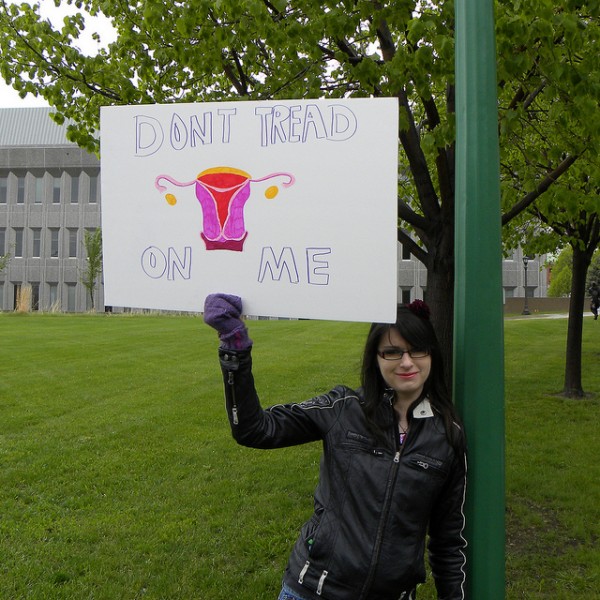
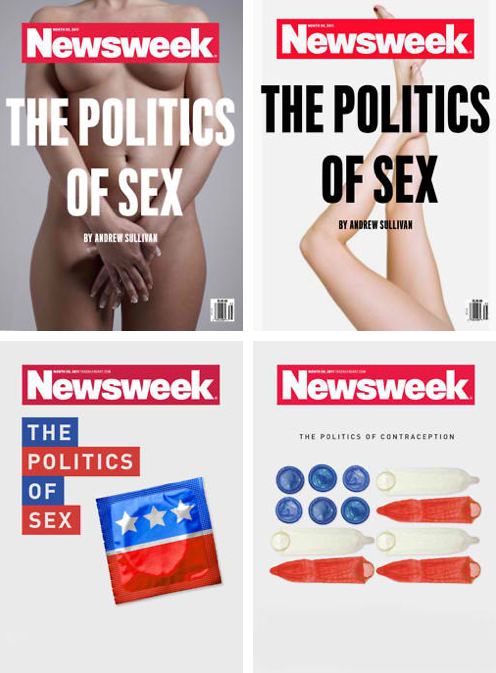
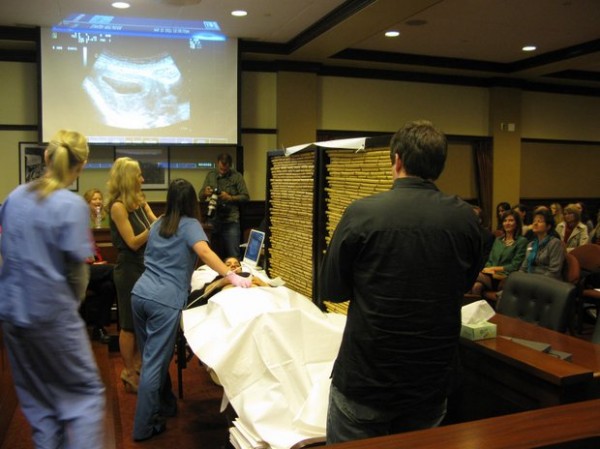



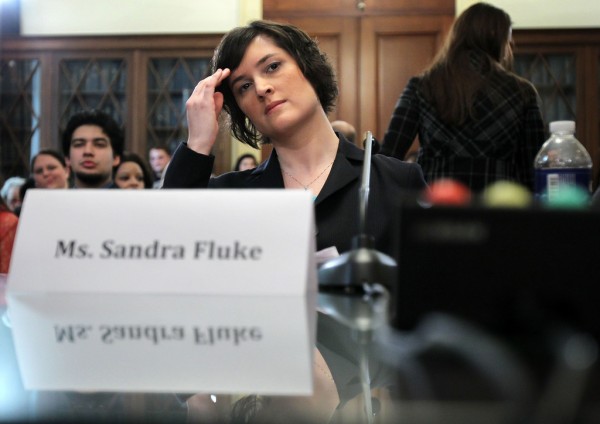
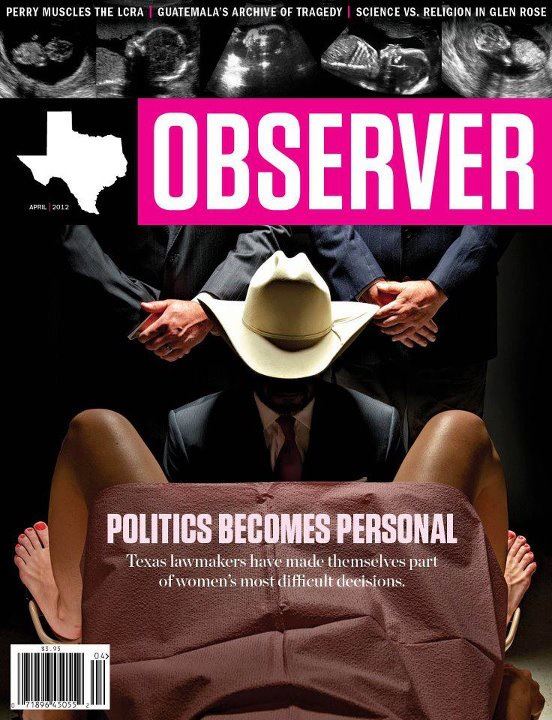
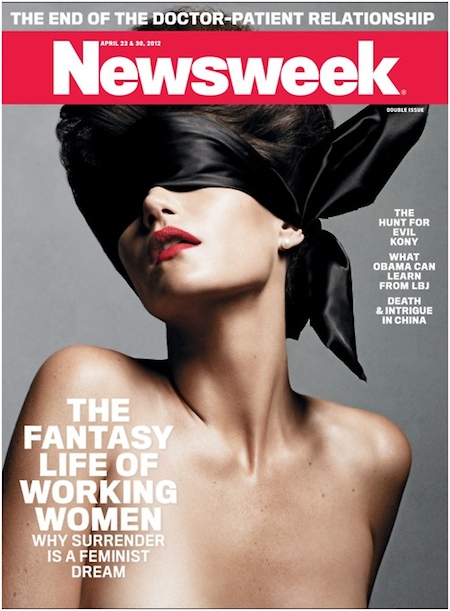











Reactions
Comments Powered by Disqus